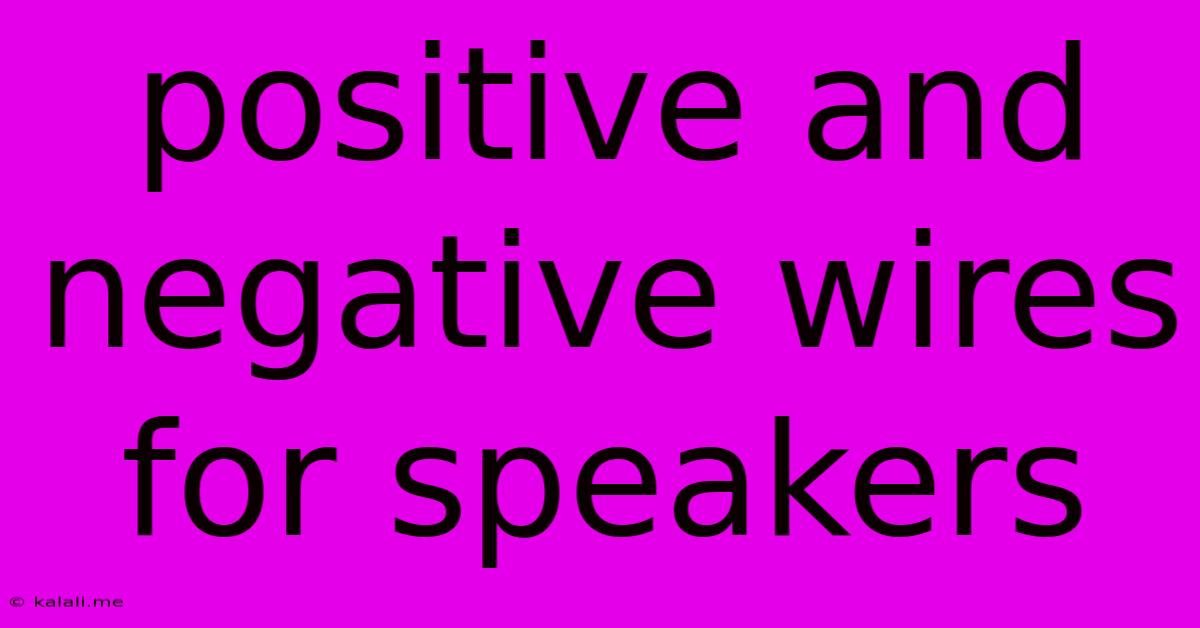Positive And Negative Wires For Speakers
Kalali
May 22, 2025 · 3 min read

Table of Contents
Understanding Positive and Negative Speaker Wires: A Complete Guide
Meta Description: Learn the crucial role of positive and negative speaker wires in proper audio setup. This guide explains polarity, its importance for sound quality, and how to correctly connect your speakers for optimal performance. Avoid common mistakes and get the best sound from your system!
Connecting your speakers might seem straightforward, but understanding the importance of positive (+) and negative (-) speaker wires is crucial for achieving optimal sound quality. Getting the polarity wrong can significantly impact your listening experience, leading to a dull, thin, or even distorted sound. This comprehensive guide explains the significance of these wires and how to connect them correctly.
What is Speaker Wire Polarity?
Speaker wire polarity refers to the correct orientation of the positive (+) and negative (-) terminals on your speaker and amplifier. These terminals are designed to allow the electrical signal to flow in a specific direction. Think of it like a highway: the signal needs to travel in the right lane for smooth passage.
Essentially, the amplifier generates an electrical signal that pushes and pulls the speaker cone to create sound. The positive wire carries the “push” signal, while the negative wire carries the “pull” signal. When these signals are out of sync (incorrect polarity), the speaker cones’ movement becomes less efficient and the sound suffers.
Why is Correct Polarity Important?
Connecting your speakers with incorrect polarity has several negative consequences:
-
Reduced Bass Response: One of the most noticeable effects is a significant reduction in bass frequencies. The bass becomes thin and weak, lacking the depth and punch it should have.
-
Phase Cancellation: With incorrect polarity, the sound waves from the positive and negative signals can interfere with each other, causing phase cancellation. This results in a loss of clarity and detail, making the sound muddy and indistinct.
-
Poor Imaging: Sound imaging, the ability to pinpoint the location of instruments or voices in a soundstage, is severely affected. It can become harder to distinguish individual elements within the audio mix.
-
Overall Dull Sound: The overall impact is a less enjoyable listening experience; the sound will lack dynamism and vibrancy.
Identifying Positive and Negative Terminals
Speaker wires themselves don't inherently have positive or negative properties; the polarity is defined by the connections at both ends. Most speaker wires are color-coded to help with identification:
- Red or (+): Generally represents the positive terminal.
- Black or (-): Generally represents the negative terminal.
However, always double-check the markings on your amplifier and speakers, as color-coding conventions can vary.
How to Connect Your Speakers Correctly
The process is simple, but crucial:
-
Identify the terminals: Locate the positive (+) and negative (-) terminals on both your amplifier and speakers. Look for clearly marked symbols or color-coded connectors.
-
Match the polarity: Connect the red (+) wire from your amplifier to the red (+) terminal on your speaker. Similarly, connect the black (-) wire from your amplifier to the black (-) terminal on your speaker.
-
Repeat for all speakers: Ensure that all your speakers are connected with the correct polarity.
-
Test the sound: Once connected, play some music and listen carefully. If something sounds off, double-check your connections.
Troubleshooting Incorrect Polarity
If you suspect your speakers are wired incorrectly, try swapping the connections of the positive and negative wires on one speaker. This should dramatically improve the sound quality, confirming the issue. If it doesn't improve the sound, there might be a different problem with your audio setup.
Conclusion
While seemingly minor, correctly connecting your speaker wires with regard to positive and negative polarity is essential for achieving the best possible audio experience. Paying attention to this detail will unlock the full potential of your speakers, resulting in a more immersive and enjoyable listening experience. Remember to always double-check your connections and listen for any improvement or changes. Don't let a simple detail diminish the quality of your audio.
Latest Posts
Latest Posts
-
How To Divide A Big Number By A Small Number
May 22, 2025
-
Installer Information On The Recovery Server Is Damaged
May 22, 2025
-
Difference Between A Pub And A Bar
May 22, 2025
-
Find The Nth Term Of A Quadratic Sequence
May 22, 2025
-
What Is The Difference Between Single And Double Cream
May 22, 2025
Related Post
Thank you for visiting our website which covers about Positive And Negative Wires For Speakers . We hope the information provided has been useful to you. Feel free to contact us if you have any questions or need further assistance. See you next time and don't miss to bookmark.